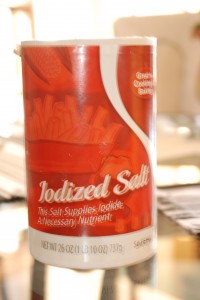I read an article from the Harvard Heart Letter on beating high blood pressure with food. I wanted to trace back the source data, a study published in The New England Journal of Medicine (NEJM) in June 2010, especially after reading a number of NEJM letters to the editor in an October edition of the journal.
Then I got sidetracked by the iodine aspects of the diet, noting that one of the letters suggested a low salt intake could result in iodine deficiency.
I'm on a no-added-salt diet myself (for high blood pressure). I've been on one for thirty years and my BP is excellent, especially now that I'm lean (151.6 pounds this morning, about what I weighed in 8th grade). So I probably meet the new, lower United States salt intake recommendations, about 1,200 mg of sodium for those of us who are over 50, are African Americans, have hypertension or diabetes; that's 70% of all Americans.
My wife and I frequently use kosher salt when we cook. It contains no iodine, whereas common table salt is iodized. So do I need to switch to using regular salt? My calculations said iodized salt, added at 1/2 tsp. per day would contribute 1190 milligrams of sodium and about 100 micrograms of iodine.
So where should we get our 150 micrograms a day of iodine (that's the suggested intake for adult men and women, although pregnant women should get 220 micrograms and lactating women 270 micrograms). Those seem to be standard recommendations, although I've read some that vary a little from those figures.
I found a stark reference in another NEJM letter saying iodine deficiency affects more than 1/3 of the world's population, an estimated 2.2 billion people. It is the foremost cause of preventable mental retardation worldwide and even in its mild forms can affect the brain function of kids.
My wife and I take a senior multivitamin daily; my reading indicates that almost all of those contain 150 micrograms of iodine. But a Boston University Medical Center study of prenatal vitamins, found considerable variance from the listed iodine content in many brands, both OTC and prescription. They suggested pregnant women should take prenatals that contain potassium iodide and urged the drug companies to make sure their products contain enough iodine as potssium iodide, since the amount of iodine in kelp varies considerably.
Then there's the question of dietary iodine. Another study, reported at the April 2010 meeting of the American Association of Clinical Endocrinologists (AACE) was titled "Iodine Content of Fast Foods Contributes Little to Iodine Levels in the Body." That study noted only one fast food chain consistently used iodized salt and that milkshakes and one chain's chicken sandwiches had the most iodine (the primarily latter from constituents other than the chicken).
Over the years since the 1971 National Health and Nutrition Examination Survey (NHANES), to the 2000-2001 NHANES, mean urine iodine levels fell by over 50%. We haven't got a widespread iodine deficiency problem in this country...yet.
The AACE president said, "The way to protect the general public from iodine deficiency is to make sure there is more regular use of multivitamins containing potassium iodide,"
So with all that as background, and reading that we can tolerate iodine intakes of 1,000 to 1,1000 micrograms a day if we're over age 4, I'm not going to increase my salt intake, but I will continue my varied diet, perhaps eat more seafood, and take my senior vitamin daily.



The "salt pig" is new to me - seems like it would be very handy.